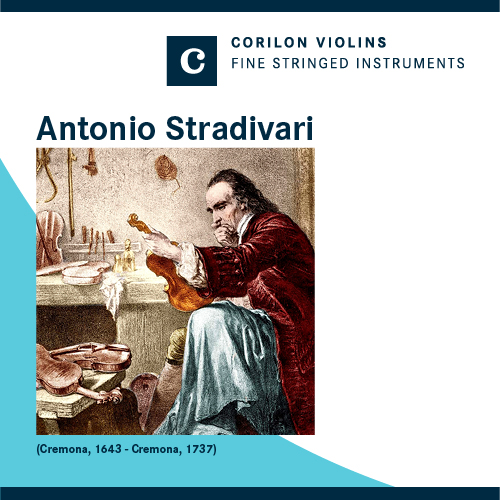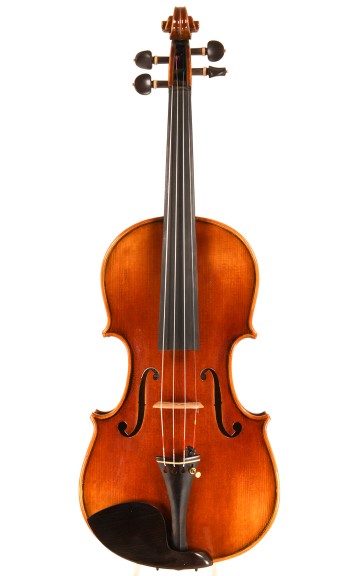Antonio Stradivari (Italian violin maker, c.1644–1737, Cremona) was one of the most historically influential violin makers and the Stradivarius violin model defined the standards in violin making that are still fundamental today. Antonio Stradivari's late work from the so-called "Golden Period" was an artistic revolution; the incomparably good sound of a Stradivarius violin has occupied violin makers and researchers for generations. Today, Antonio Stradivari violins are traded at prohibitive prices of 10 - 15 millions.
How did his ingenious, influential Stradivari violin model come about - and why are Stradivarius violins among the most expensive stringed instruments traded today?
- Stradivari and Amati: who was Antonio Stradivari’s teacher?
- The Stradivari violin model
- Stradivari’s secret
- Overview of the phases in Antonio Stradivari’s oeuvre
- The perpetual crown princes: Omobono and Francesco Stradivari

- The last genuine Stradivarius violins
- Stradivaris from a conveyor belt: a brand is inflated
- How much does an authentic Stradivari violin cost?
- Antonio Stradivari's heirs: the master's great successors
Antonio Stradivari and the musical revolution of Cremona
Antonio Stradivari (Antonius Stradivarius) lived during a period of profound transitions, and in its nearly Biblical duration of well over 90 years, his lifetime spans more than an epoch of European musical history. As is so often the case in many old stories, there are a few gaps here that historic research has not yet been able to close. For example, it is regrettable that we cannot definitively ascertain what year the greatest luthier in the history of violin making was born. However, if we accept as fact his own markings on a violin label dated 1727 on which Stradivari wrote that he crafted the violin at the age of 83, we can assume that he was born in 1644.
It was the era of Spanish rule in Italy, and Cremona suffered under this government as much as it did from the social and economic impact of the major plagues of the 1630s. In light of that situation, Antonio Stradivari’s family, which was one of the city’s traditional bloodlines, left Cremona and settled elsewhere in safety. This is presumably why Antonio Stradivari’s birth was not documented in any church register
Stradivari und Amati – who was Antonio Stradivari's teacher?
By a similar token, there is no conclusive evidence as to the circumstances in which he learned the craft of making violins and lutes, nor is it known who his teacher was. Did he perhaps first train as a carpenter? And could his teacher truly have been the great Nicolo Amati in Cremona?  Antonio Stradivari personally appeared to allude to this by designating himself alumnus Nicolai Amati on labels in his early violins. But does this truly mean there was a teacher-student relationship between them, or was the young luthier Antonio Stradivari simply paying tribute to the undisputed pioneer of his craft – an homage that was not completely free of a certain entrepreneurial cleverness?
Antonio Stradivari personally appeared to allude to this by designating himself alumnus Nicolai Amati on labels in his early violins. But does this truly mean there was a teacher-student relationship between them, or was the young luthier Antonio Stradivari simply paying tribute to the undisputed pioneer of his craft – an homage that was not completely free of a certain entrepreneurial cleverness?
Antonio Stradivari violin model
In whatever fashion Stradivari may or may not have been a student of Amati, one thing is certain: Antonio Stradivari’s success in becoming a luthier meant the success of skilled interpreter of Amati's work, and Stradivari owed his rapid ascent not to his revolutionary reformulation of the violin model which earned him his exceptional place in the history of musical instruments. Instead, he owed it to his faithful implementation of principles inspired by Amati, and, last but not least, to the aesthetic beauty of his work. The fact that Antonio Stradivari had Amati templates in his workshop until his death is an indication of the relevance he ascribed to the relationship to his "master” – no matter whether the term is meant literally or figuratively here. It was not until approximately 1684 at the age of around 40 that he he began experimenting and initiated a transition that was astonishing in its radical effects:
- In the ten or so years that followed, the bodies of his instruments varied in their length and width, and above all, Stradivari gradually lowered the table. This was a critical step in improving the sound, since a flatter top can resonate more easily than one with a higher arch.
- The sound holes grew broader in the course of this period.
- Last but not least, Stradivari made thorough modifications to the formula for the varnish he used.
By making these modifications along with many other minor adjustments, the master appears to have focussed his attention on achieving a sound that was more powerful, resonant and assertive and to merge this with the acoustic merits of his previous work. A great deal of speculation has been made about the reasons for this sudden transition, and it is likely that there is a grain of truth in every attempt at a theory which explains Antonio Stradivari's motivation. There is no denying that brilliant ideas and artisanal curiosity played a part, whereas the good response his new violins received from excellent soloists and composers confirmed that his primary concern was defining a new profile of acoustic standards in the music of his day. The expansion of the orchestra and the development of the solo concerto and the concerto grosso are both plausible explanations for the revisions he made to his work, or rather for the revisions which were made throughout the entire mainstream of Italian baroque violin making, a circle where Antonio Stradivari successfully managed to create loyalty amongst a very interesting clientele. The fact that many other masters in addition to Stradivari began to experiment as well is often overlooked; the Italian violin-making period around 1690 can be described as a phase of sometimes bold experimentation in which the comparatively young standards of the violin family were in flux.

Antonio Stradivari's secret
The question remains, however: what was the critical characteristic that defined the remarkable quality and the exceptionally good sound of the new Stradivari model which reached its full maturity around 1695? New conjecture about this question arises at regular intervals – was it perhaps the varnish, and did it have a secret formula that, as an exciting legend would have it, Stradivari's descendants have kept under lock and key to this day? As entertaining as such speculation ― and its less spectacular equivalents ― may be, these theories are in no way to be considered a serious analysis of this epoch-defining oeuvre. A stringed instrument is a complex system whose quality is never a matter of a single element; it depends on each and every one of its components being of a consistently high quality.
Even the varnish, which Stradivari's clients appreciated (albeit more for its aesthetic quality), was a contributing factor but cannot be regarded as "the" secret of "the" Stradivari violin. The instruments of the great Cremonese master Antonio Stradivari are historic achievements in violin making, which owe their rank in musical history to many individual aspects, one of which is the way in which these components created a harmonious whole. To this day, studying these issues in detail remains one of the best educational tools for luthiers who want to perfect their expertise and their craftsman ability.
Overview of the phases in Antonio Stradivari’s oeuvre
| „Amatisé“: Antonio Stradivari’s earlier work, which was patterned after Nicolò Amati, presumably his teacher | 1667 – ca. 1684/85 |
| Transitional period: Working with the Maggini model; lowering the table and modifying the thickness of the top to expand the sound; creating the larger "Longuet" model | 1684/85 – ca. 1695 |
| Further refinement of the Stradivari model | 1695 – 98 |
| The “golden years” | c. 1700 – 1720 |
| Later work | c. 1725 – 37 |
The perpetual crown princes: Omobono and Francesco Stradivari
Of Antonio Stradivari's eleven children, only Francesco Stradivari (born in 1671) and his brother Omobono Stradivari , who was eight years younger, followed in their father's footsteps – and spent their careers in their father’s shadow. It may seem surprising that the Stradivari family workshop did not undergo a smooth transition to the next generation despite its remarkable financial successes, but that was due to Stradivari himself. His exceptional mastery and productivity on into an advanced age – more specifically, until his death well past the age of ninety – left no space for Francesco Stradivari in particular to develop on his own. Even though Antonio's later instruments show a certain imprecision here and there, their sound still fulfils all of the expectations of the finest musicians, then and now – and as a result, his personal creations remained the ultimate benchmark, even in the generation that followed him. Omobono Stradivari was the only one who dared to strike out on his own, leaving for Naples at the age of 18 and probably turning his back on violins, only to return eventually and help his father and brother at the workshop.
The influence of Stradivari père appears to have been so dominant that only vague information is known about the sons' work: it is assumed that they never managed to emancipate themselves from the status of being highly qualified hired hands, and they only survived Antonio by a few years. As a result, the personal artisanal accomplishments of Omobono are all but lost to history, whereas Francesco Stradivari did manage to have somewhat of an influence on the 1730 "forma B" cello model and the mandolins produced at the Stradivari workshop. The rest of his legacy, which encompassed over 50 years of work, has been obscured by history.
The last genuine Stradivari violins
So what remained after the master and his sons died and no other talented students took their place? The Antonio Stradivari workshop was left without a direct descendant. Initially, there were still many instruments left that the father bequeathed to different members of his family, although this only represented a small number of the estimated 1,000 or so instruments which Stradivari and his sons produced in the course of their remarkably long careers. Some 650 have survived to date, although this figure is not conclusive due to the unknown provenance of many pieces. Most of them are considered investments and kept in well-secured safes or can be admired in museums – not only in the world-famous Museo del Violino in Stradivari’s home town of Cremona, but in many other countries around the world. Only a few remain in the hands of musicians, usually as loans, and this is a regrettable state of affairs which is due in no small part to the global success to the Stradivari "brand" since the 19th century and the subsequent financial speculation surrounding historic masterpieces of violin making.
Stradivari violins from a conveyor belt: a brand is inflated
The interest in old Italian masters in general and Stradivari in particular which began to explode in the late 18th century was also responsible for the fact that “assembly-line Stradivaris" began to be manufactured in practically all of the important centres of industrial violin production. Replicas of labels, marks and catalogues featuring Stradivari's unprotected name were used for advertising – another powerful testament to the influence of a master who embodied the very opposite of mass production, given his singular nature and the way in which his work was tied to his person. Nevertheless, to a certain extent the factories in Saxony (Germany), France and elsewhere were justified in their approach, since even their millions of products were defined by the innovative strength which the Stradivari myth had raised to new levels centuries ago. Whereas a mass-produced Chinese violin could not possibly be farther away from the famous "Messiah" or "Hellier," to name only two of his world-famous instrumental luminaries, the mass-market version would not exist at all without the historic Stradivari model.
How much does an authentic Stradivarius violin cost?
The legendary value of genuine Stradivari violins regularly captivates public attention, such as it did in the year 2016, when a violinist left her €2.4 million Stradivarius lying in a regional train.  And the latest record-breaking auction results always consistently find their way into the media, such as when the famous “Lady Blunt” was sold, the Stradivarius which has undergone the greatest increase in value to date: in 1871 the violin was sold at Sotheby’s for the equivalent of approximately $200,000 in today’s money, but in 2011 the Lady Blunt generated the breathtaking sum of $15.9 million at Tarisio. The fact that the proceeds of this auction were donated to victims of the Tōhoku earthquake and tsunami may have had a further impact on the final sum. Be that as it may, however: such figures reflect the massive increase in the prices of top-quality historical instruments, especially those by Stradivari. There is no end in sight to this development.
And the latest record-breaking auction results always consistently find their way into the media, such as when the famous “Lady Blunt” was sold, the Stradivarius which has undergone the greatest increase in value to date: in 1871 the violin was sold at Sotheby’s for the equivalent of approximately $200,000 in today’s money, but in 2011 the Lady Blunt generated the breathtaking sum of $15.9 million at Tarisio. The fact that the proceeds of this auction were donated to victims of the Tōhoku earthquake and tsunami may have had a further impact on the final sum. Be that as it may, however: such figures reflect the massive increase in the prices of top-quality historical instruments, especially those by Stradivari. There is no end in sight to this development.
Stradivari's heirs: the master's great successors
The direct influence that Antonio Stradivari had on the generations of Italian violin makers that followed was not initially as great as one might assume in light of his fame today. The violins patterned after Amati continued to enjoy great popularity, particularly in Italy; their musical properties corresponded to widespread musical preferences, particularly in the field of chamber music. Jakob Stainer's work also exerted an impact that endured even into parts of the 19th century, and various local schools shaped the diverse nature of European violin making in the early 18th century; examples include the distinctive models by Caspar Hopf in the “music corner” region of Saxony and Bohemia, or the work of Jacob Krauchdaler who influenced southern Germany and northern Switzerland.
Nevertheless, a line can clearly be drawn connecting Antonio Stradivari to the finest violin makers of our time, even if this tradition is not as evident in a straightforward trajectory of teacher-student relationships as it is in the repeated use and analysis of the historic templates Stradivari created. The features of these instruments are not only part of the fundamentals that young luthiers learn; they are also the connecting element in the artistic development of many excellent masters. One example is Christoph Götting, who worked on several Stradivaris during his many years at J. & A. Beare in London, and in the course of this process, he gained important insights he applied not only to his own instruments but to his life’s work: varnish. In a similar fashion, Antonio Stradivari’s instruments have served as an ongoing source of inspiration for Parisian master Stephan von Baehr, who began to consider the work of the great Cremona violin makers early in his career as an employee of Andreas Kaegis – and ultimately matured into one of the most interesting luthiers of our day, in no small part due to the inspiration of a period that lies in the past yet remains dynamic.
Related information:
Guarneri - Cremonese violin making in Stradivari's shadow
On the life of the Tyrolean violin maker Jakob Stainer
Samuel Zygmunowicz : understanding Stradivarius
Jérôme Thibouville-Lamy – J.T.L.





